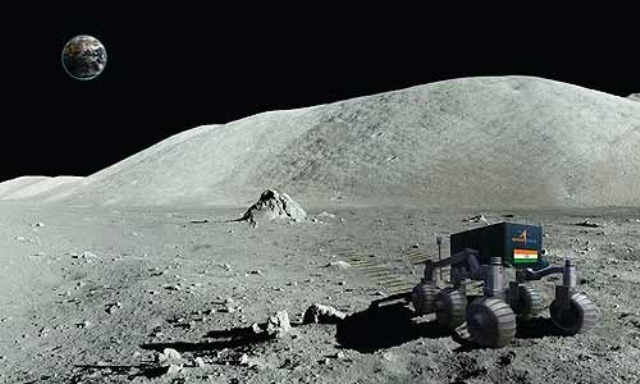Chandrayaan 2 is ready to take a billion dreams to the Moon now stronger than ever before! Join us for the launch on Monday 22 July, 2019 at 2:43 PM IST,” ISRO had tweeted on July 18 while announcing the rescheduled launch. On the eve of launch, ISRO Chairman K Sivan said all preparations were on and the glitch had been rectified. “Whatever technical snag we observed on July 15 has been rectified. The vehicle is in good health… The (pre-launch) rehearsal has been successfully completed,” he told reporters at the Chennai airport on brief a stopover enroute here. On Wednesday, Indian Space Research Organisation (Isro) said that Chandrayaan-2 is scheduled to launch in the middle of July 9 and July 16 this year. The space agency is expecting to land the rover on Moon this year on September 6.
HIGHLIGHTS
- Chandrayaan-2 is India’s second mission to the Moon and would be launched on July 15
- Chandrayaan-2 aims to explore the Moon’s south polar region – uncharted territory so far
- India after a successful landing will become the fourth country ever to soft land on the lunar surface
- Isro said that the performance of Chandrayaan-2 was normal after rehearsals for the rescheduled launch at 2.43pm on Monday
- The 20-hour countdown for the launch started at 6.43pm on Sunday
- The July 15 launch was called off after a leak was detected in the cryogenic stage of the rocket, just an hour before blast-off
Chandrayaan 2 Moon Landing Live Updates
“We have to find out from the communication data whether it is a soft landing or it is a crash landing. In my opinion, it is not a crash landing because the communication channel is on between the lander and the orbiter. It should be intact. So, let us hope after the analysis done, we may be able to get the final figure,” he said while talking to ANI. The communication data which is missing is being analysed now, he said.
Earlier, Indian Space Research Organisation (ISRO) said in a tweet, “normal performance was observed up to an altitude of 2.1 km. Subsequently, communication from Lander to the ground stations was lost. Data is being analyzed.”
Chandrayaan-2 is the second lunar exploration mission of India after Chandrayaan-1. It is developed by the Indian Space Research Organisation (ISRO) and the mission is scheduled to be launched to the Moon by a Geosynchronous Satellite Launch Vehicle Mark III (GSLV Mk III). It comprises a lunar orbiter and lander as well as rover and it is all developed by India.
The lander has been named Vikram while on the other hand, the rover is named Pragyan. Rover Pragyan is going to be kept inside lander Vikram and will be set out after Vikram lands on lunar surface.
GSLV-Mk III / Chandrayaan-2 Mission
Chandrayaan-2 is going to attempt to soft-land a lander as well as a rover in a high plain in the middle of two craters such as Manzinus C and Simpelius N, at a latitude of around 70° south. If the mission gets successful then Chandrayaan-2 is going to be the second mission to land a rover close the lunar south pole. ISRO up till now have to schedule launch date for Chandrayaan 2.
?? #ISROMissions ??
We are ready for one of the most exciting missions, #Chandrayaan2. Launch window between July 9-16 & likely Moon-landing on Sept 6, 2019. #GSLVMKIII will carry 3 modules of this #lunarmission – Orbiter, Lander (Vikram), Rover (Pragyan).
More updates soon. pic.twitter.com/jzx9CMwUhR
— ISRO (@isro) May 1, 2019
As per to ISRO, this mission is going to use and test several new technologies and held new experiments. The wheeled rover is going to move on the lunar surface and will carry out on-site chemical study. The data is going to be transmitted to Earth through the Chandrayaan-2 orbiter, which will allied on the same launch.
Which of these theories is correct? Is there a fifth alternative that no one else has considered? We are looking to find the answer to these questions and more through Chandrayaan 2 — the world’s first mission to the Moon’s south polar region! pic.twitter.com/PHIcA2kr0D
— ISRO (@isro) July 9, 2019
From past ten years, this is the second time India is going to launch a mission to the Moon’s surface. In the year 2009, Isro launched Chandrayaan-1. That mission, on the other hand, did not comprise a rover. Chandrayaan-1 comprised an orbiter as well as an ‘impactor’ that collided into the Moon’s surface near the South Pole.
CHANDRAYAAN-2: INDIA’S MOON MISSION
Chandrayaan-2 will be launched from Satish Dhawan Space Center at Sriharikota, Andhra Pradesh on-board GSLV Mk-III on July 15, 2019.
GSLV stands foe Geosynchronous Satellite Launch Vehicle.

The findings from the Chandrayaan-1 mission help out the US-based National Aeronautics as well as Space Administration (NASA) to approve the existence of water on Moon.
ISRO To Launch Chandrayaan-2 Moon Mission In July 15, Landing Expected in September
Chandrayaan-1 was India’s first lunar probe which was launched by the Indian Space Research Organisation in the year 2008, and was worked until August 2009. The mission comprised a lunar orbiter as well as an impactor. India launched the spacecraft with the use of a PSLV-XL rocket, serial number C11, from Satish Dhawan Space Centre, at Sriharikota about 80 km (50 mi) north of Chennai on 22 October 2008 at 00:52 UTC.
How to watch Chandrayaan-2, Moon Landing
The mission Chandrayaan-1 was the most important enhancement to India’s space program, as India researched and established its own technology to explore the Moon. The vehicle was inserted into lunar orbit on 8 November 2008.
The Chandrayaan-1 mission also helps in laying the basis for transporting a rover to Moon, i.e. Chandrayaan-2. Chandrayaan-2 is amongst India’s most aspiring space missions of all time. The additional mission is Gaganyaan which is India’s first operated space mission.
Mission to Moon: First images of India’s Chandrayaan-2 are here

Under Gaganyaan, Isro anticipates to send total of three Indians to space on an Indian spacecraft. Separately from Rakesh Sharma, no Indian national has been to space; he, though, went to space but on a Russian spacecraft.
Chandrayaan-2 has been also given a launch window of July 9 to July 16, along with a lunar landing on Moon this year on September 6.
Vikram Lander
The lander of Chandrayaan-2 is named Vikram after Dr Vikram A Sarabhai, the father of the Indian Space Programme. It is designed to function for one lunar day, which is equivalent to about 14 Earth days.

Pragyan Rover
Chandrayaan-2’s rover is a six-wheeled robotic vehicle named Pragyan, which translates to ‘wisdom’ in Sanskrit. It can travel up to 500m and leverages solar energy for its functioning. It can only communicate with the lander.

Chandrayaan-2 Orbiter
At the time of launch, the Chandrayaan-2 orbiter will be capable of communicating with Indian Deep Space Network (IDSN) at Byalalu as well as the Vikram lander. The mission life of the orbiter is one year and it will be placed in a 100X100km lunar polar orbit.

Talking about the Chandrayaan-2, the mission is going to examine lunar soil. The rover Pragyan is going to gather samples and perform experiments, transfering its findings to the orbiter. The orbiter will then use this data and its specific findings to carry out study of lunar soil.








